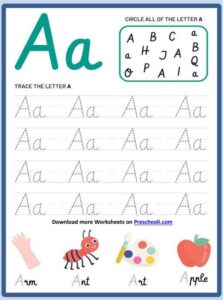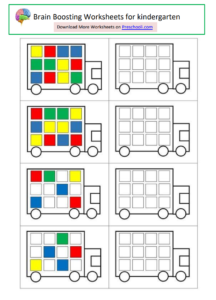The Magic of Writing Letters Worksheets in Early Education
Transforming the learning experience with interactive and engaging writing letters worksheets activities for young learners
Teaching the art of letter writing and recognition is often the first step in molding young minds into budding scholars. However, the traditional pen-and-paper approach is evolving with the advent of writing letters worksheets, which sprinkle a touch of fun into the invaluable education of children. Preschool and elementary years are crucial developmental stages, and worksheets have emerged as essential vehicles for educational growth, creativity, and cognitive development. In this comprehensive guide, we will explore the profound impact of writing letters worksheets, offering insights for parents and educators alike to enrich the learning process for little learners.
The Evolution of Learning with Worksheets
From Chalkboards to Tablets
The innocence of scribbling letters on a chalkboard during the classic era of education has now paved the way to children tapping letters on lively tablet screens. Worksheets bridge this generational gap, effectively merging traditional teaching methods with contemporary resources. They act as tangible screens for children, marrying the importance of handwriting with the excitement of technology, as young learners trace letters, match uppercase with lowercase, and engage with interactive activities.
A Multisensory Approach
Gone are the days of monotone lectures and single-sensory learning. Writing letters worksheets cater to the omnivorous data consumption habits of our digital-age kids. With vibrant colors, various textures, and a hands-on component, these worksheets stimulate multiple senses, embedding letter recognition and formation through sight, sound, and touch.
The Personalized Learning Revolution
Each child is unique, and so are their learning styles and paces. The personalization that worksheets afford cannot be overstated. They can be tailored to an individual’s needs, supporting faster learners with challenge extensions and aiding struggling students with additional practice.
The Alphabet as a Building Block
The ABCs and the Child Mind
Why are the alphabet and letters so crucial to early education? They’re more than just the foundations of language; they are the architectural blueprints for a child’s cognitive development. Writing letters worksheets allow young minds to organize abstract symbols into a structured system, reinforcing patterns and sequences that resonate with the developing brain’s need for order and logic.
Preparing for the World of Reading
The ability to read is empowering. Early exposure to reading through writing letters worksheets gives children a head start, familiarizing them with the shapes, names, and sounds of letters that will soon form words, sentences, and stories. This seamless transition to literacy is invaluable and shapes their potential for future academic success.
Building Fine Motor Skills
Before letters form on the page, a child’s fine motor skills must be developed. Writing letters worksheets can offer this prerequisite by engaging little hands in the precise movements required to trace, draw, and write. The refining of these motor skills is not only fundamental for writing but also for daily life activities such as tying shoes and cutting with scissors.
The Cost-Effective Solution in Education
Writing letters worksheets not only enrich the learning experience but are also remarkably cost-effective. Unlike digital subscriptions or learning apps that come with monthly fees, these sheets are a one-time investment, if not a free resource that can be printed out at home or school. This makes them accessible and sustainable learning tools for institutions and families, especially in third-world countries where financial constraints hinder educational methodologies.
Nurturing a Love for Learning
A Joyful Introduction to Academia
Worksheets are often a child’s first informal introduction to structured learning and can set the tone for their entire academic experience. By infusing coloring, drawing, and even storytelling into letter-writing activities, these sheets turn learning into a joyful experience, fostering a love for education that extends beyond the classroom.
Building Confidence through Mastery
There’s a special kind of pride in the small face of a child who has just mastered a new letter. Writing letters worksheets provide the platform for such victories, where each symbol conquered boosts a child’s confidence and eagerness to tackle the next challenge, laying the groundwork for a lifetime of effective learning.
The Role of Technology in Enhancing Worksheets
In a world dominated by screens, it’s no surprise that technology plays a significant role in enhancing the efficacy of writing letters worksheets. Digital templates can cater to the visual and auditory experiences demanded by modern learners. Furthermore, technology can track and assess a child’s progress, offering insights that customize the learning trajectory.
Maximizing the Benefits of Writing Letters Worksheets
Setting Clear Learning Objectives
Before introducing a worksheet, it’s important to set clear objectives. Whether it’s to teach the order of the alphabet, recognize upper and lowercase letters, or practice the sound of ‘S,’ having a goal ensures that the worksheet contributes measurably to the child’s educational growth.
The Right Way to Use Worksheets
To maximize the benefit of writing letters worksheets, use them to reinforce lessons rather than replace other forms of education. Children learn best through a variety of methods, and worksheets serve as one of many tools in the educational arsenal.
The Role of the Adult in the Worksheet Experience
The adult’s involvement is key when it comes to worksheets. Parents and educators can guide, encourage, and provide feedback as children work through the material. This supportive role turns independent learning into collaborative experiences.
Engaging Children in the Worksheet Process
Making Worksheets Exciting
A vibrant and visually appealing worksheet can excite children’s imaginations and motivate them to engage with the content. Incorporating their favorite characters or themes can turn what may seem like work into fun.
Balancing Fun with Education
While fun is an essential component, balancing it with educational value ensures the worksheets are both enjoyable and productive. Combining games with learning activities helps maintain a healthy equilibrium.
Encouraging Creativity
Creative elements, such as drawing or crafting stories around the letters, can turn worksheets into personal expressions of learning. Encouraging children to approach the material from their unique perspective fosters a deeper connection with the educational process.
Worksheets in a Distanced Learning World
Adapting to a Remote Learning Environment
With the recent shift towards distanced learning, the importance of engaging educational materials has never been more relevant. Writing letters worksheets have proven to be adaptable to virtual platforms, offering tactile learning experiences even through a screen.
The Social Dimension of Worksheets
Worksheets can also be used as a catalyst for social interaction, as children share their completed assignments during video calls or collaborate on joint projects. This social dimension supports the development of communication skills, which are equally crucial in a child’s education.
Overcoming Challenges with Worksheets
Tailoring for Special Needs
Educators and parents of children with special learning needs face unique challenges. Tailoring worksheets to accommodate these needs—whether through larger fonts, tactile materials, or simplified layouts—ensures that all children can benefit from the educational experience.
Adapting to Individual Student Paces
Each child has their own learning pace. Involve children in tracking their progress, whether through simple checkmarks or color-coded systems, so they can witness their growth and take ownership of their learning process.
The Environmental Impact
Sustainable Practices in Preparation
Choosing recycled paper for worksheets aligns with sustainable practices and teaches children the importance of environmental stewardship. It’s a subtle yet powerful lesson that can be woven into the larger fabric of their education.
The Digital-Print Balance
While digital worksheets offer convenience, a balance with print materials can foster an understanding of energy conservation and e-waste management. It’s an opportunity to teach children about responsible technology usage from an early age.
Case Studies and Success Stories
Real-World Applications of Worksheets
From urban classrooms to rural kindergartens, the application of writing letters worksheets has yielded positive results across diverse settings. Case studies and success stories can serve as blueprints for effective implementation strategies.
Measuring the Impact
Tools exist to measure the impact of writing letters worksheets on a child’s educational growth. By collecting and analyzing data, we can quantifiably understand how these materials contribute to early literacy and beyond.
The Future of Writing Letters Worksheets in Education
Emerging Technologies and Trends
With technology constantly transforming the educational landscape, we can expect writing letters worksheets to evolve with it. Augmented reality, artificial intelligence, and interactive video platforms are just some of the innovations on the horizon.
Pioneering New Strategies
Incorporating strategies such as gamification or adaptive learning into writing letters worksheets can push the boundaries of how we engage young learners. It’s an exciting time for educational innovation, with opportunities to make learning more dynamic and personalized than ever before.
Conclusion
The sheer versatility and impact of writing letters worksheets on a child’s education cannot be overlooked. From the foundational fostering of motor skills to the cultivation of literacy and a lifelong love of learning, these simple sheets are powerful tools for any parent or teacher aiming to enrich a child’s educational experience. By blending the innocence of scribbles with the precision of the alphabet, we set our children on the path to success, one worksheet at a time.
Join our Facebook Group



